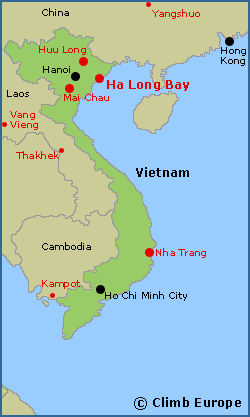Rock climbing in Vietnam
Ha Long Bay’s towering sea cliffs are Vietnam’s most well-known and popular climbing destination. Here there is a paradise of adventure climbing ranging from sport climbing to deep water soloing (DWS). However there are other climbing areas in Vietnam, mainly around the city of Hanoi.
Rock Climbing at Ha Long Bay
Ha Long Bay is the jewel in the crown of Vietnamese climbing and has long been considered a paradise of adventure climbing, with both sport climbing and deep water soling available. The Bay lies in the Gulf of Tonkin just off Vietnam's northern coastline where there are approximately 1,600 limestone karst islands with steep walls rising directly out of the sea.

Some of the limestone karst islands of Ha Long Bay
Ha Long Bay is home to the largest concentration of sport routes in Vietnam with over 180 routes from F4+ to F8a. These are located on Cat Ba Island and various other smaller islands in the bay. Cat Ba Island is home to numerous well-bolted crags that offer a good diversity of climbing with a range of styles on good quality limestone rock. There are 5 main crags with the largest being Butterfly Valley, Ben Beo Harbour, Buddha Cave and Hidden Valley. Access to these crags is usually via a scooter ride (cheap and easy to hire) that adds to the overall adventure. Out in the bay there are 13 well established crags offering sport and some Trad climbing. Some of the larger sport climbing crags are Moody Beach, The Amphitheatre, and Tiger Beach, where it is sometimes necessary to delay directly from a boat (again easy to hire).
DWS in Ha Long BayHowever, the Bay area is famous for its deep water soloing (DWS) where there is an almost limitless number of routes. Some of the popular crags include Polish Pillar, Hawaii 5-0, and Three Brothers, though there are 20 established island crags in Ha Long Bay for deep water soling. The climbing style tends to be on overhanging rock featuring tufas, cracks and traverses, with over 170 established routes ranging from F4+ to F7c+. It should be noted that the bay has a unique tidal system where high tides are more frequent during certain times of the year. A high tide of at least 2.2m is recommended to safely climb these deep water soloing routes. These high tides occur primarily between June and November, with the best climbing months being June, September, October, and November. Access to these deep water soloing routes is via a boat, and it is important to personally check tide heights before setting off.
The Vietnam rock climbing guidebook details all the sport climbing and deep water soling in Ha Long Bay and Cat Ba Island.
Map of the main rock climbing areas in Vietnam

Other Climbing areas in Vietnam
Huu Lung is located to the north of Hanoi with perfect limestone rock featuring pockets, tufas, crimps and slopers, mainly vertical and steep rock, and is Vietnam’s second largest climbing area. There are over 120 sport routes ranging from F4+ to F8b, including one serious multi-pitch route called Chuć Suć Khoé (F6b+ obligatory or F7a max).
Quoc Oai is a limestone massif that rises from the rice paddy fields, located just outside of Hanoi’s metropolis. There are around 20 routes and it is easily accessible in a day trip from the city.
Mai Chau is located to the southwest of Hanoi. The climbing is in a valley overlooking rice paddy fields, creating a unique and isolated climbing paradise. The climbing is on good quality limestone rock across a wide range of grades. Routes vary from steep vertical faces to three-dimensional problem solving on monster tufas.
The Vietnam rock climbing guidebook describes over 500 routes ranging from sport climbing and deep water soloing, along with some trad and bouldering lines. The majority of the routes covered are in Ha Long Bay and Cat Ba Island, with 184 sport routes from F4+ to F8a, and 174 deep water soloing routes from F4+ to F7c+. The guidebook also includes the sport climbing at Huu Lung, Quoc Oai, and Mai Chau near Hanoi.